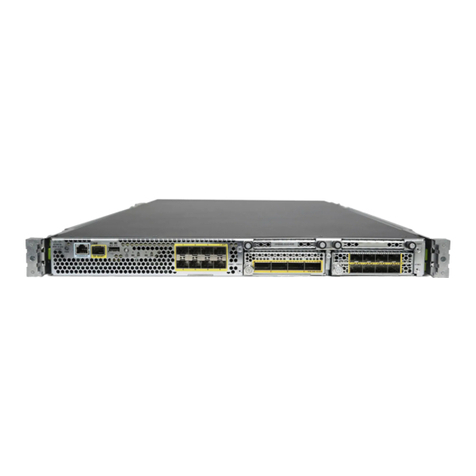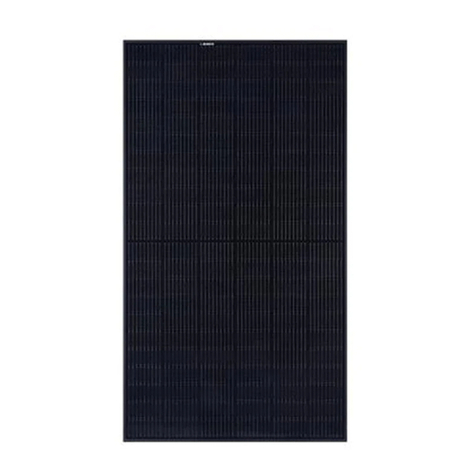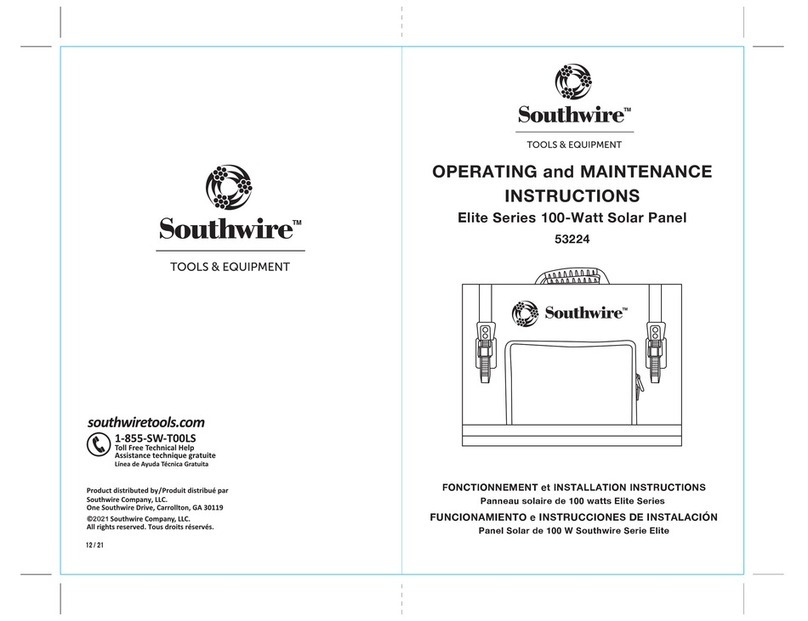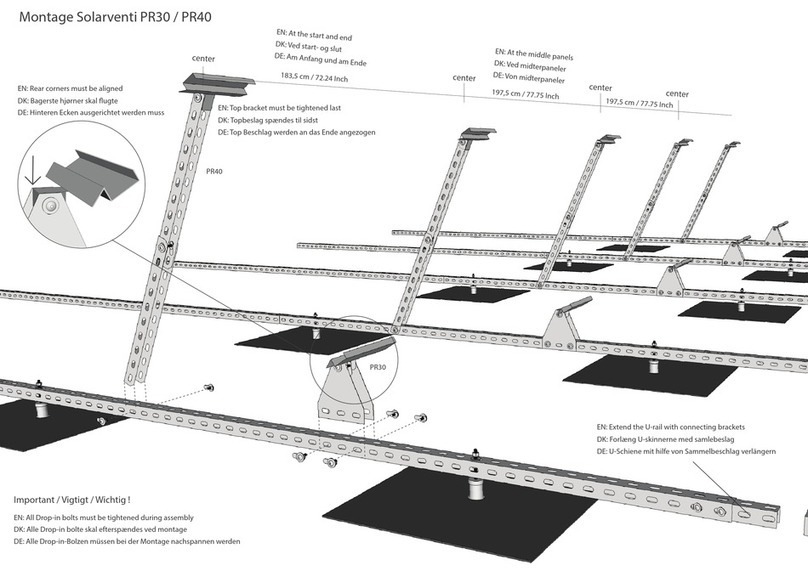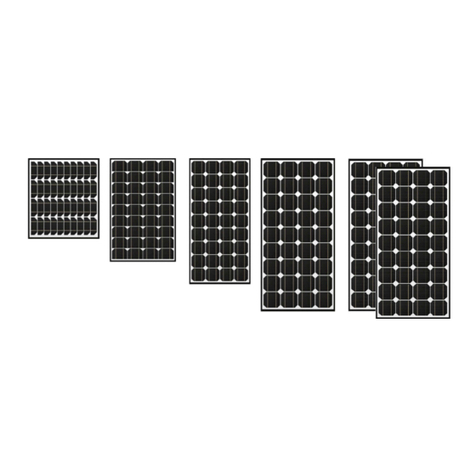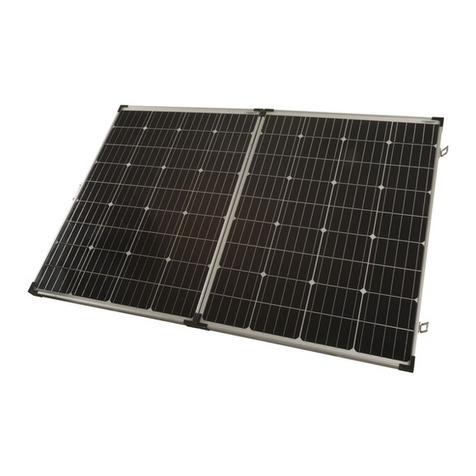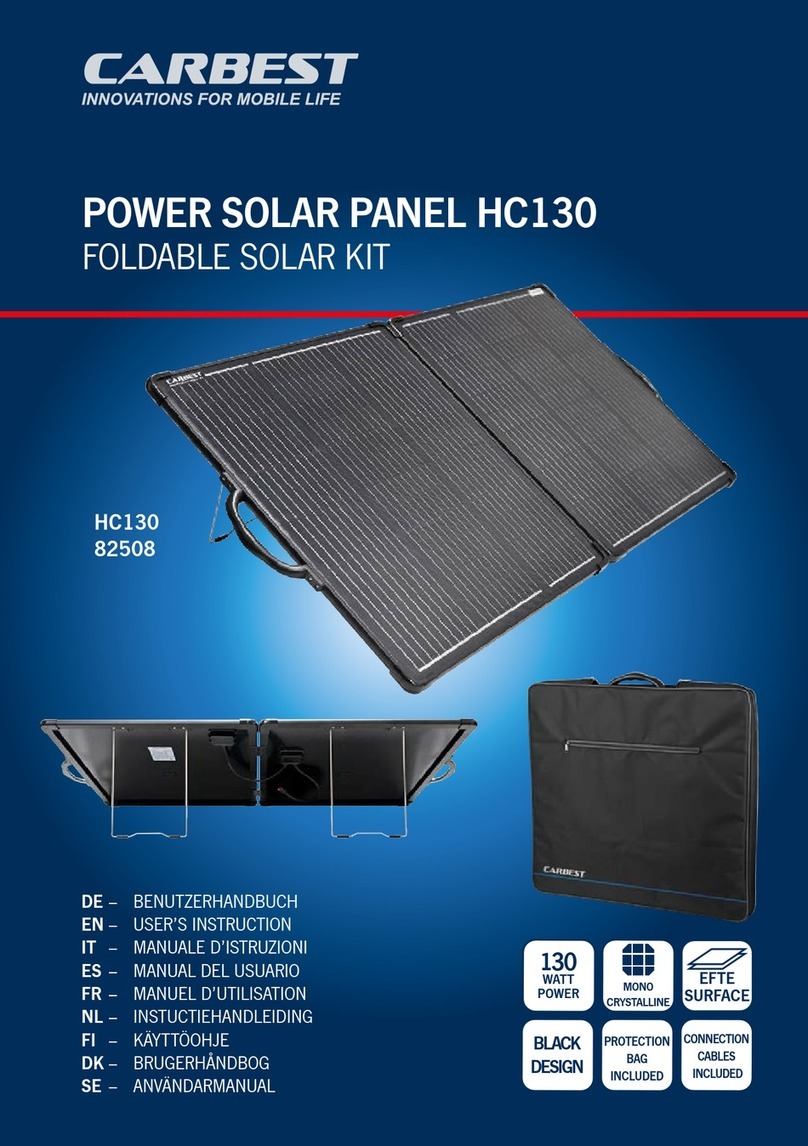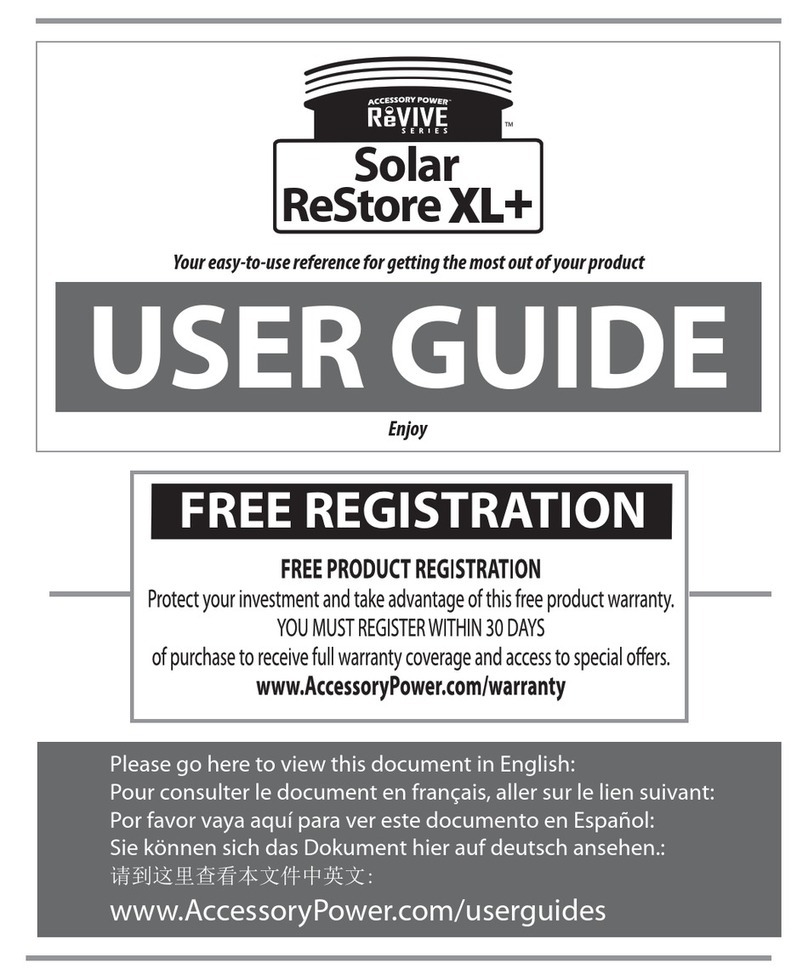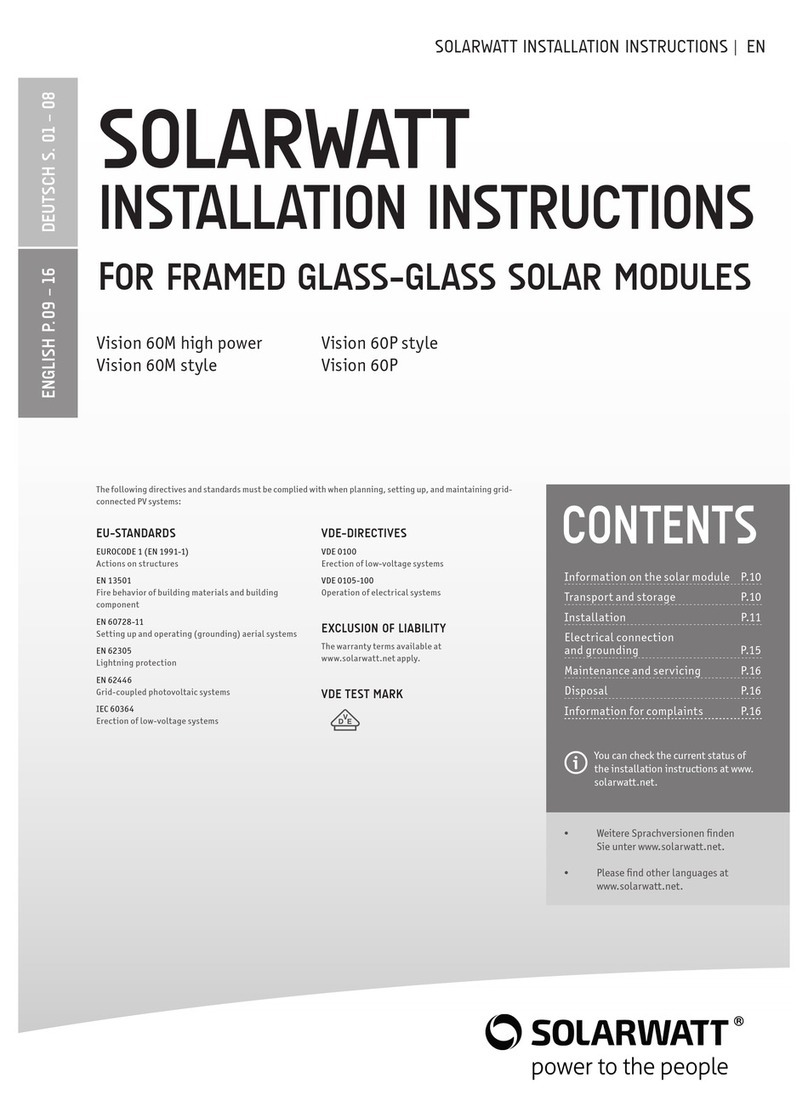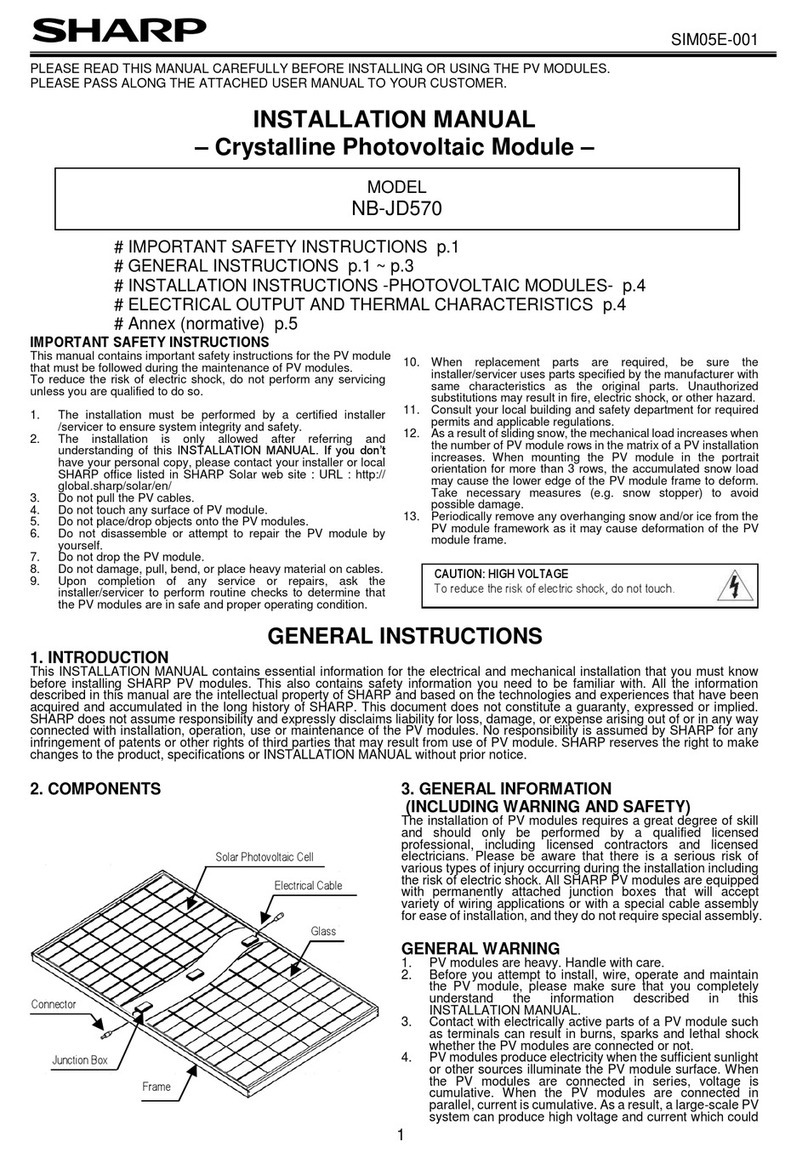ET Solar ET SOLAR Series User manual

INSTALLATION
MANUAL (IEC)
ET SOLAR SERIES MODULE
Installation | Safety instructions | Maintenance
INFORMATION ABOUT MANUFACTURER:
ET SOLAR CHINA
Please consult your dealer or the manufacturer concerning the warrantyof
your modules. If you have any further questions, your dealer andET Solar will
gladly assist you.
Tel: 86 25 86897287
E-mail: [email protected]
www.etsolar.com
Building 3 No.1, Yaojia Road Jiulong Town,
Hailing District, Taizhou, China

This guide contains information regarding the installation and safe handling of ET
Solar photovoltaic modules (hereafter referred to as "modules"). All instructions should
be read and understood before attempting installation. If there are any questions,
please contact your dealer or ET Solar for further information. The installer should
conform to all safety precautions in the guide when installing modules. Before
installing a solar photovoltaic system, the installer should become familiar with the
mechanical and electrical requirements for photovoltaic systems. Keep this guide in
a safe place for future reference. If not otherwise specified, it is recommended that
the requirements of the U.S. National Electrical Code (NEC) or respective European
Code be followed.
Non-compliance with this installation instruction may result in property damage
and/or physical injury. ET Solar will not be liable for compensation of any loss or injury
caused by this type of non-compliance.
www.etsolar.com Subject to technical modifications without notice. 2016 © ET Solar Group www.etsolar.com Subject to technical modifications without notice. 2016 © ET Solar Group 1
1
2
2.1
2.2
3
3.1
3.2
4
4.1
4.2
4.3
5
5.1
5.2
5.3
5.4
6
7
8
TABLE OF CONTENTS 1. PURPOSE OF THIS GUIDE
Installing solar photovoltaic systems requires specialized skills and knowledge. The
installer assumes all risk of injury, including risk of electric shock. Module installation
should be performed only by qualified persons.
All modules come with a permanently attached junction box and #12 AWG (4 mm²)
wire terminated in Multi Contact PV connectors. Your dealer can provide additional
extension cables to simplify module wiring.
Each individual module can generate DC voltages greater than 30 volts (V) when
exposed to direct sunlight. Contact with a DC voltage of 30 V or more is potentially
hazardous. Exercise caution when wiring or handling modules exposed to sunlight.
When disconnecting wires connected to a photovoltaic module that is exposed to
sunlight, an electric arc may occur. Arcs can cause burns, start fires or otherwise
create safety problems. Exercise caution when disconnecting wiring on modules
exposed to sunlight.
2. GENERAL
www.etsolar.com
Purpose of this guide
General
Safety precautions for installing a solar photovoltaic system
General installation notes
Mechanical Installation
Selecting the location
Selecting the proper mounting structure and hardware
Mounting methods
Mounting with bolts
Mounting with clamping hardware
Anti-salt module mounting procedure
Electrical Installation
Grounding
Wire
General electrical installation
Electrical ratings of the concerned modules
Testing, debugging and troubleshooting
Maintenance
Disclaimer of liability
1
1
2
3
4
4
4
4
5
5
6
9
9
10
11
12
12
13
14

www.etsolar.com Subject to technical modifications without notice. 2016 © ET Solar Group www.etsolar.com Subject to technical modifications without notice. 2016 © ET Solar Group
2 3
Photovoltaic solar modules convert light energy to direct-current electrical
energy, and are designed for outdoor use. Proper design of support structures is
the responsibility of the system designer and installer.
Modules may be ground mounted, pole mounted, or mounted on rooftops.
Do not apply paint or adhesive to the module.
When installing modules, observe all applicable local, regional and national
codes and regulations. Obtain a building and/or electrical permit where required.
Storage Temperature: -10 C ~40 C, Storage Humidity: ≤70%RH;
Modules should operate at environmental temperature of between -40 to +85℃. If
modules are to be installed in areas where the temperature may go outside the
above range, please consult with ET Solar before installation.
Observe the instructions and safety precautions for all other components used in
the system, including wiring and cables, connectors, DC-breakers, mounting
hardware, inverters, etc.
Use only equipment, connectors, wiring and mounting hardware suitable for use in
a photovoltaic system.
Always use the same type of module within a particular photovoltaic system.
Under normal operating conditions, PV modules will produce currents and
voltages that are different from those listed in the date sheets. The values in the
module data sheets are collected under very specific circumstances known as
Standard Test Conditions.
Short-circuit current and open-circuit voltages should be multiplied by a factor of
1.25 when determining component voltage ratings, conductor ampacity, fuse
sizes and size of controls connected to the module or system output. An
additional multiplying factor of 125 percent (80 percent de-rating) may be
applicable.
Drainage holes must not be covered with parts of the mounting system. The
junction box has a breather port which must be mounted facing downward and
cannot be exposed to the rain. The junction box should be on the higher side of
the module when it is mounted in order to orient the breather port correctly.
Do not lift the module by grasping the module's junction box or electrical leads.
Do not stand or step on module.
Do not drop the module or allow objects to fall on the module.
Do not place any heavy objects on the module.
Do not scratch the anodized coating of the frame (except for grounding
connection).
Do not scratch the glass surface.
Prior to installation, do not store modules outdoors or in a damp environment.
Inappropriate transport and installation may damage the module glass or frame.
Solar modules produce electrical energy when exposed to sunlight. DC voltages
may exceed 30V on a single exposed module.
Only connect modules with the same rated output current in series. If modules are
connected in series, the total voltage is equal to the sum of the individual module
voltages.
Only connect modules or series combinations of modules with the same voltage in
parallel. If modules are connected in parallel, the total current is equal to the sum
of individual module or series combination currents.
Bypass diodes are preassembled in each module. Do not remove these diodes.
Keep children well away from the system while transporting and installing
mechanical and electrical components.
Completely cover all modules with an opaque material during installation to
prevent electricity from being generated.
Do not attempt to disassemble the module, and do not remove any attached
nameplates or components. Doing so will void the warranty.
Do not use mirrors or other hardware to artificially concentrate sunlight on the module.
Use appropriate safety equipment (insulated tools, insulating gloves, etc)
approved for use on electrical installations.
2.1 Safety precautions for installing a solar photovoltaic system
Do not wear metallic rings, watchbands, ear, nose, or lip rings or other metallic
devices while installing or troubleshooting photovoltaic systems.
www.etsolar.com
2.2 General installation notes

www.etsolar.com Subject to technical modifications without notice. 2016 © ET Solar Group www.etsolar.com Subject to technical modifications without notice. 2016 © ET Solar Group
4 5
Select a suitable location for installation of the module.
For optimum performance, the module must be facing true south in northern
latitudes and true north in southern latitudes.
For detailed information on optimal module orientation, refer to standard solar
photovoltaic installation guides or a reputable solar installer or systems integrator.
Shading on the module will reduce electricity production.
Do not install the module near equipment or in locations where flammable gases
can be generated or collected.
Observe all instructions and safety precautions included with the mounting system
to be used with the module.
Do not drill holes in the glass surface of the module. Doing so will void the
warranty.
Do not drill additional mounting holes in the module frame. Doing so will void the
warranty.
Modules must be securely attached to the mounting structure using four mounting
points for normal installation. If heavy wind or snow loads are anticipated,
additional mounting points should also be used. Please see the drawing below.
Load calculations are the responsibility of the system designer or installer.
The mounting structure and hardware must be made of durable, anti-corrosion
and UV-resistant material.
4.1 Mounting with bolts
A minimum of four module clamps should be used, two on each long/short frame
side, in the general clamping areas denoted by the wide arrows on the drawing.
Other mounting methods are acceptable as long as the minimum requirements
as described under term 4.2 mounting with clamping hardware are met.
If module clamps are used to secure the module, The torque should refer to
mechanical design standard, we recommend the following torque for bolt:
M6------9 N.m
M8------16~20 N.m
3. MECHANICAL INSTALLATION
4. MOUNTING METHODS
www.etsolar.com
3.1 Selecting the location
3.2 Selecting the proper mounting structure and hardware
4.2 Mounting with clamping hardware
The module must be attached and supported by at least four bolts through the
indicated mounting holes.
Most installations will use the four inner mounting holes on the module frame.
Depending on the local wind and snow loads, additional mounting points may be
required.
Four or Eight pre-drilled mounting holes, located on the aluminum alloy frame, are
provided for ease of installation. They are designed to be used with metric M8
stainless steel screws. We recommend to use a tighten torque of 16~20 N.m
Mounting hole installation
Use four mounting holes
snow load 2400Pa/wind load 2400Pa
Use four mounting holes
snow load 5400Pa/wind load 2400Pa

www.etsolar.com Subject to technical modifications without notice. 2016 © ET Solar Group www.etsolar.com Subject to technical modifications without notice. 2016 © ET Solar Group
6 7
4.3 Anti-salt module mounting procedure
For photovoltaic systems to be installed near the coastline, we recommend using ET
SOLAR Anti-salt modules with the following installation action items.
www.etsolar.com
Mainstream Grounding Methods:
Grounding System Installation Steps:
Recommended mounting methods
Grounding bolt
Grounding wire
Fluorocarbon paint
Fluorocarbon paint
Grounding wire ring
Grounding wire
Option 2
Before the installation of each module, clean the frame installation area (35mm by
100mm surrounding the grounding hole) and keep it dry.
Choose either one of the two options described in the diagrams above to properly
ground the module.
Spray varnish on the yellow portion of the diagram covering the entire grounding
area. We recommend fluorocarbon varnish.
For mounting system with bolts, refer to picture 1 and 2.
Hexagonal screw
Plain washer
Elastic washer
Insulation gasket
Picture1 Picture 2
1)
2)
3)
Clamping installation
Use four clamps on short frame
snow load 5400Pa/wind load 2400Pa
Permissble position of clamps
Use four clamps on long frame
snow load 2400Pa/wind load 2400Pa
Permissble position of clamps
1/4 L ±50mm 1/4 L ±50mm
1/4 L ±50mm 1/4 L ±50mm
Use four clamps on long frame
snow load 5400Pa/wind load 2400Pa
Permissble position of clamps
1/4 of module lenth 1/4 of module lenth
1/4 of module lenth 1/4 of module lenth

5. ELECTRICAL INSTALLATION
www.etsolar.com Subject to technical modifications without notice. 2016 © ET Solar Group www.etsolar.com Subject to technical modifications without notice. 2016 © ET Solar Group
8 9
For mounting system with clamps, refer to picture 3 and 4.
To ensure optimum modules performance at project sites near the coastline, we
recommend the following maintenance services once every 3 months:
Inspect the frames, mounting systems, grounding holes and other easily corrodible
areas.
Clean the frames, mounting systems, grounding holes and other areas subject to dust
and salt accumulations.
To maintain and repair installation sites that are rusty and corroded:
Clean up the dust and salt accumulations around the rusty areas.
Spray fluorocarbon varnish on all installations and rusty areas. Make sure that no area
is missed.
For other operation and maintenance guidance, please refer to near-coast
installation standard.
www.etsolar.com
Maintenance
Attentions
5.1 Grounding
Aside from components that are parts of the grounding circuit, all other components
should be insulated from the module frames using non-conductive gaskets.
For fluorocarbon varnish or other chemicals, please follow the instructions strictly,
personal protective equipment (such as goggle, mask, gloves etc) may be needed
during the operation.
No photovoltaic module should be installed within 50 meters from the edge of the
coastline.
In areas between 50 meters and 500 meters from the edge of the nearest coastline,
we recommend ET SOLAR Anti-salt Modules to be used in photovoltaic energy systems
installations.
In areas greater than 500 meters from the edge of the nearest coastline, we
recommend conventional modules to be used in photovoltaic energy systems
installations.
Picture
3 Picture 4
Briquetting
Nut
Plain washer
Bolt
Insulation gasket
All module frames must be properly grounded.
Observe all local electric codes and regulations.
A bonding or toothed washer is required to make proper and reliable electrical
grounding connection with the anodized aluminum frame.
Devices listed and identified for grounding metallic frames of PV modules are
permitted to ground the exposed metallic frames of the module to grounded
mounting structures.
Consider using a lay-in lug, rated for outdoor use, if the module grounding conductor
is to be larger than #10 AWG.
When using lay-in lugs, the grounding conductor should be inserted into the opening
indicated in the figure, and secured using the set screw.
1)
2)
1)
2)
3)

www.etsolar.com Subject to technical modifications without notice. 2016 © ET Solar Group www.etsolar.com Subject to technical modifications without notice. 2016 © ET Solar Group
10 11
www.etsolar.com
5.2 Wire
5.3 General electrical installation
When connecting parallel modules strings to the distribution box, use proper
third-party PV system connectors with suitable length PVF type cable which are
qualified for EN50521 and 2PFG1169. All field wiring cables must have large enough
cross-sectional areas approved for use at the maximum short-circuit current of the PV
module. ET Solar recommends that installers use only sunlight resistant cables (PVF1
type) for direct current (DC) wiring in PV systems. The recommended minimum wire
size should be 4 mm² and must be subject to the local national codes and regulations.
The connecting cables must not cross each other and must be kept away from direct
sunlight, heat source and any static pool of water. The cables should be secured by
the modules mounting structure and should maintain a distance of at least 25 mm
from one another with no possibility of coming into contact.
The connectors should be kept dry and clean. Do not attempt to make electrical
connections between wet, soiled, or otherwise faulty connectors. Faulty connections
can result in electrical shocks and arcs.
Expect for equipment grounding, ET Solar recommends the negative pole of PV
module array is connected to earth during all PV system installations. That will keep
optimal performance of PV Power Plants, which are located in a hot, high humidity
climate and high Maximum System Voltage.
The junction box on each PV module has two wires that terminate in a male and a
female connector. When the modules are to be connected in series, the male
connector should be plugged into the female connector of the neighboring module
while the female connector should be plugged into the male connector of the other
neighboring module.
Do not use modules of different configurations in the same system.
This module is supplied with Multi Contact connectors for electrical connections.
Refer to local code to determine appropriate types and temperature ratings of
conductors. Wiring should be #12 AWG, 4 mm² (minimum) and must be temperature
rated at 90 °C (minimum).
Completely cover system modules with an opaque material to prevent electricity from
being generated while disconnecting conductors.
Refer to local code to determine over current, conductor ampacity and size
requirements.
Installation shall be in accordance with local code.
PV module grounding with lay in lug (φ4mm grounding holes)

6. TESTING, DEBUGGING AND TROUBLESHOOTING
7. MAINTENANCE
www.etsolar.com Subject to technical modifications without notice. 2016 © ET Solar Group www.etsolar.com Subject to technical modifications without notice. 2016 © ET Solar Group
12 13
www.etsolar.com
5.4 Electrical ratings of the concerned modules
Troubleshooting for low voltage
For best performance, ensure that positive and negative DC wires run closely together
to avoid loops.
Blocking diode can be used in PV system to prevent reverse current from the battery if
there is no photovoltaic current in the module. If charge controllers are not used, then
it is recommended to use blocking diodes. For more details on charge controllers,
please consult with professionals.
In cases where two or more modules are connected serially in a system, if part of the
modules are occluded and the other part are exposed to the sun, the high reverse
current will flow partially or completely through the module, causing the modules to
overheat and even damaging the modules. Bypass diode used in modules can
protect modules from such impact of excessive reverse current..The bypass diodes
have been integrated in the junction box.
Operators should protect themselves from electrical shock during debugging or
maintenance of solar systems.
There are two causes of low open circuit voltage, environmental change or circuit
fault. The drop of irradiance or increase of environmental temperature reduces the
open circuit voltage, which is normal. The troubleshooting here refers to the low
voltage caused by circuit faults, which is usually due to incorrect connection of
terminals or damage of bypass diodes.
First, check all wiring connections, and ensure they are well-connected into the PV
system. Then check the modules one by one as below:
Measure the open circuit voltage of a module.
Cover the module completely with opaque material.
Disconnect the module from the system.
Remove the opaque material from the module, and measure its open circuit voltage.
If the measured voltage is one third or two thirds of the rated value, it indicates that
bypass diodes don’t work well, and should be replaced.
WARNING!
Electrical shock hazard!
Do not touch bare conductors or other potentially energized parts.
Please refer to ET module datasheets. Datasheets can be downloaded from website:
www.etsolar.com
Use digital multimeter to check the total open circuit voltage of the serially
connected modules. The results should be equal to the sum of the open circuit
voltage of individual modules, which can be found from the label on the modules. If
the total open circuit voltage is much lower than expected, please follow the
following procedure in this instruction.
Test procedure for modules serial connected before connect them to the PV system.
ET Solar recommends the following maintenance items to ensure optimal performance
of the module:
Clean the glass surface of the module as necessary. It is recommended to clean the
glass surface with pressured running water compliance with local drinking standards,
e.g. low mineral content, near neutral PH value. The maximum water pressure
recommended is 1 MPa and the water jet is at least 50cm away from the glass
surface. Do not use dishwasher detergent. Do not have water staying on the glass
surfaces of PV modules for a long time.
If a module power decreases abnormally, and its glass surface is found covered by
dust, please contact your module installer, retailer or ET solar immediately for technical
support.
Do not attempt to clean a module if the front glass is broken or the backsheet is
perforated.

Shutting down the system
8. DISCLAIMER OF LIABILITY
www.etsolar.com Subject to technical modifications without notice. 2016 © ET Solar Group www.etsolar.com Subject to technical modifications without notice. 2016 © ET Solar Group
14 15
www.etsolar.com
Electrical and mechanical connections should be checked periodically by qualified
personnel to verify that they are clean, secure and undamaged.
Check the electrical and mechanical connections periodically to verify that they are
clean, secure and undamaged.
Problems should only be investigated by qualified personnel.
Observe the maintenance instructions for all other components used in the system.
Completely cover system modules with an opaque material to prevent electricity from
being generated while disconnecting conductors.
Disconnect system from all power sources in accordance with instructions for all other
components used in the system.
The system should now be out of operation and can be dismantled. In doing so,
observe the all safety instructions as applicable to installation.
Because the use of this manual and the conditions or methods of installation, operation,
use and maintenance of photovoltaic products are beyond ET Solar's control, ET Solar
does not accept responsibility and expressly disclaims liability for loss, damage, or
expense arising from or in any way connected with improper installation, operation, use or
maintenance . Improper installation, operation, use or maintenance means that
installation, operation, use or maintenance does not strictly follow this manual and/or the
local, regional and national codes and regulations.
ET Solar shall not be any way responsible or liable for natural causes, including but not
limited to normal wear and tear of photovoltaic products, the natural effects of exposure
to weather conditions over time and the outdoor dust build-up.
ET Solar shall not be in any way responsible or liable for the end user Customer or any
third-party arising out of any non-performance or delay in performance of any terms
and conditions of sale, including this manual, due to fire, flood, blizzard, hurricane,
thunder, acts of God, changes of public policies, terrorism, war, riots, strikes,
unavailability of suitable and sufficient labor or materials and other events which are
out of control of ET Solar.
No responsibility is assumed by ET Solar for any infringement of patents or other rights
of third parties, which may result from use of the PV product. No license is granted by
implication or otherwise under any patent or patent rights.
The information in this manual is based on ET Solar's knowledge and experience and
is believed to be reliable, but such information including product specification
(without limitations) and suggestions does not constitute a warranty, expressed or
implied. ET Solar reserves the right to change the manual, the product, the
specifications, or product information sheets without prior notice.
This manual suits for next models
1
Table of contents
Other ET Solar Solar Panel manuals
Popular Solar Panel manuals by other brands

Viessmann
Viessmann VITOSOL 100-F Technical data manual
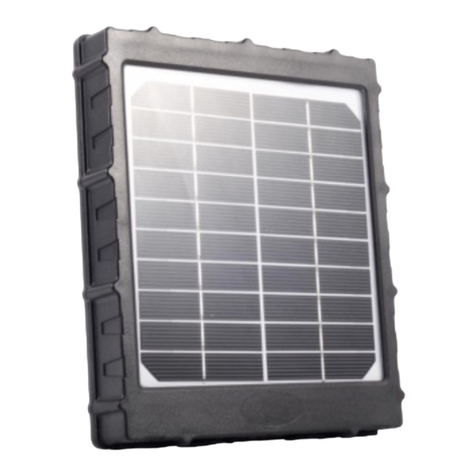
Hunter
Hunter Solar Panel Plus SP150 user manual

Viessmann
Viessmann Vitosol-F Type SV installation instructions
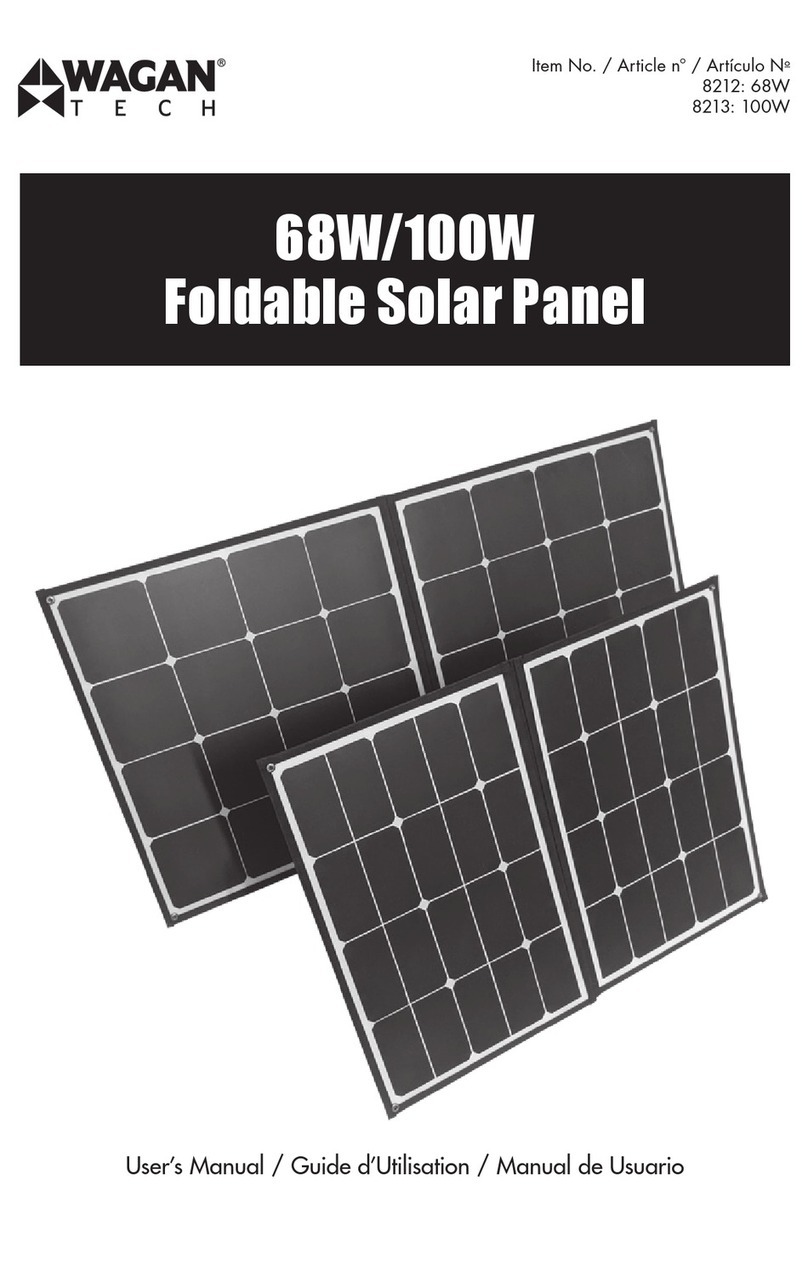
Wagan
Wagan 8212 user manual

Viessmann
Viessmann Vitosol-F Series installation instructions
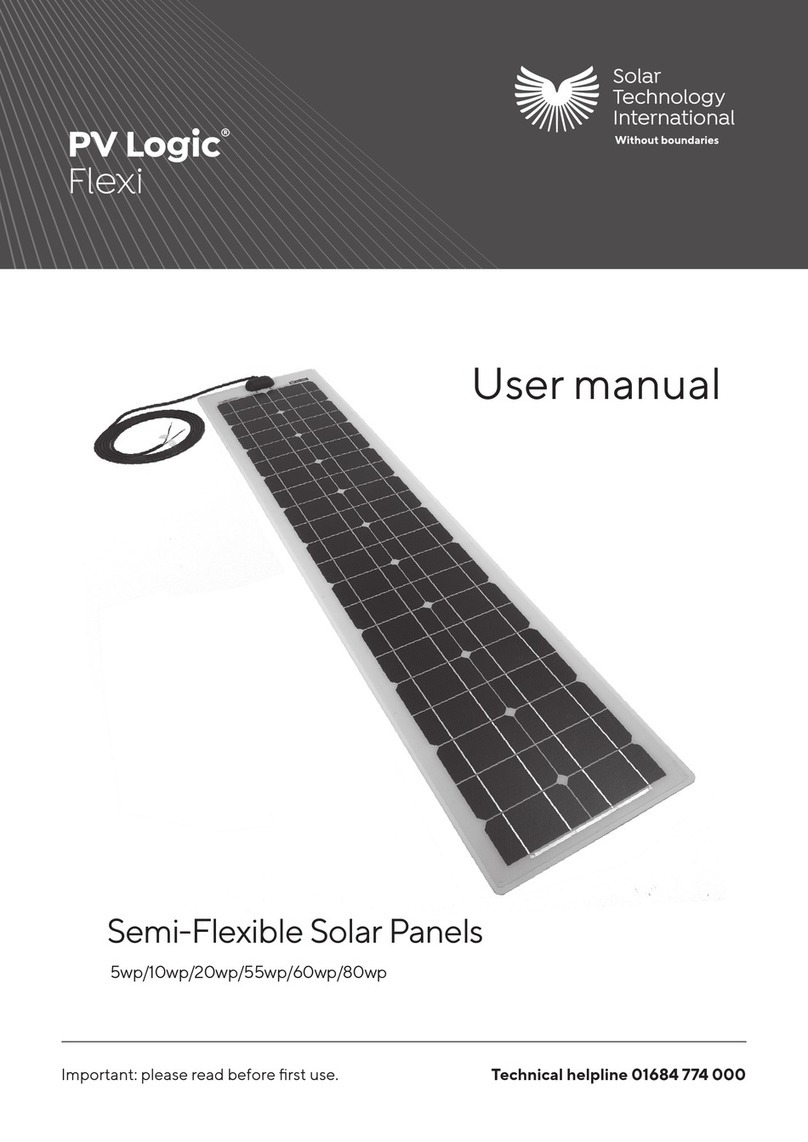
Solar Technology International
Solar Technology International PV Logic Flexi user manual



